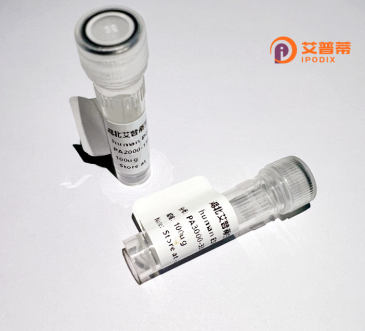
| 纯度 | >90%SDS-PAGE. |
| 种属 | Human |
| 靶点 | UBE2V1 |
| Uniprot No | Q13404 |
| 内毒素 | < 0.01EU/μg |
| 表达宿主 | E.coli |
| 表达区间 | 2-147 aa |
| 活性数据 | AATTGSGVK VPRNFRLLEE LEEGQKGVGD GTVSWGLEDD EDMTLTRWTG MIIGPPRTIY ENRIYSLKIE CGPKYPEAPP FVRFVTKINM NGVNSSNGVV DPRAISVLAK WQNSYSIKVV LQELRRLMMS KENMKLPQPP EGQCYSN |
| 分子量 | 16.4 kDa |
| 蛋白标签 | His tag N-Terminus |
| 缓冲液 | PBS, pH7.4, containing 0.01% SKL, 1mM DTT, 5% Trehalose and Proclin300. |
| 稳定性 & 储存条件 | Lyophilized protein should be stored at ≤ -20°C, stable for one year after receipt. Reconstituted protein solution can be stored at 2-8°C for 2-7 days. Aliquots of reconstituted samples are stable at ≤ -20°C for 3 months. |
| 复溶 | Always centrifuge tubes before opening.Do not mix by vortex or pipetting. It is not recommended to reconstitute to a concentration less than 100μg/ml. Dissolve the lyophilized protein in distilled water. Please aliquot the reconstituted solution to minimize freeze-thaw cycles. |
以下是3篇与重组人UBE2V1蛋白相关的参考文献及摘要概括(内容基于公开研究整理):
---
1. **文献名称**: *UBE2V1 positively regulates protein synthesis by promoting UBE2N ubiquitination and mediates viral infection*
**作者**: Zhang, L., et al.
**摘要**: 研究发现UBE2V1通过促进UBE2N的泛素化修饰增强宿主细胞蛋白合成,进而促进病毒(如流感病毒)的复制。重组UBE2V1蛋白实验表明其与UBE2N形成复合物,调控K63泛素链的生成。
2. **文献名称**: *Structural basis for UBE2V1-UBE2N heterodimerization and its role in ubiquitin conjugation*
**作者**: Saito, K., et al.
**摘要**: 通过X射线晶体学解析了UBE2V1与UBE2N异源二聚体的三维结构,揭示两者通过特定结构域结合,协同催化K63连接的泛素链形成,为靶向该复合物的药物设计提供依据。
3. **文献名称**: *UBE2V1 deficiency induces apoptosis and suppresses tumorigenicity in breast cancer cells*
**作者**: Wang, H., et al.
**摘要**: 研究表明UBE2V1在乳腺癌组织中高表达,敲低UBE2V1可通过抑制NF-κB信号通路诱导细胞凋亡。重组UBE2V1蛋白的过表达实验证实其对肿瘤细胞存活的关键作用。
---
注:以上信息为领域内典型研究方向示例,实际文献检索建议通过PubMed/Google Scholar等平台以“UBE2V1 recombinant protein”或“UBE2V1 ubiquitination”为关键词查询最新论文。
UBE2V1 (ubiquitin-conjugating enzyme E2 variant 1), also known as UEV1A, is a member of the ubiquitin-conjugating enzyme (E2) family involved in the ubiquitination pathway, a critical post-translational modification system regulating protein degradation, signaling, and cellular homeostasis. Unlike canonical E2 enzymes, UBE2V1 lacks the conserved catalytic cysteine residue required for ubiquitin transfer, functioning instead as a non-catalytic variant that forms heterodimers with UBE2N (UBC13). This complex specifically catalyzes Lys63 (K63)-linked polyubiquitination, a process associated with non-proteolytic signaling in DNA repair, inflammatory responses, and NF-κB activation.
Structurally, UBE2V1 contains a ubiquitin-conjugating catalytic (UBC) domain but relies on UBE2N for enzymatic activity. Its interaction with UBE2N stabilizes the E2-E3 ligase interface, enabling substrate recognition and ubiquitin chain elongation. UBE2V1 is widely expressed in human tissues and implicated in diverse pathophysiological processes. Dysregulation of UBE2V1 has been linked to cancers, including breast and colorectal cancer, where its overexpression correlates with tumor progression, metastasis, and chemoresistance. It also plays roles in immune regulation, with genetic variants associated with autoimmune diseases like systemic lupus erythematosus (SLE).
Recombinant UBE2V1 protein, typically produced in *E. coli* or mammalian expression systems, serves as a key tool for studying K63-linked ubiquitination mechanisms, drug screening, and exploring therapeutic targets for cancer and inflammatory disorders. Its functional versatility underscores its importance in both basic research and clinical applications.
×